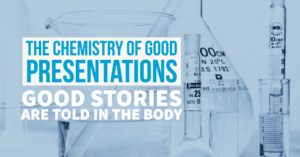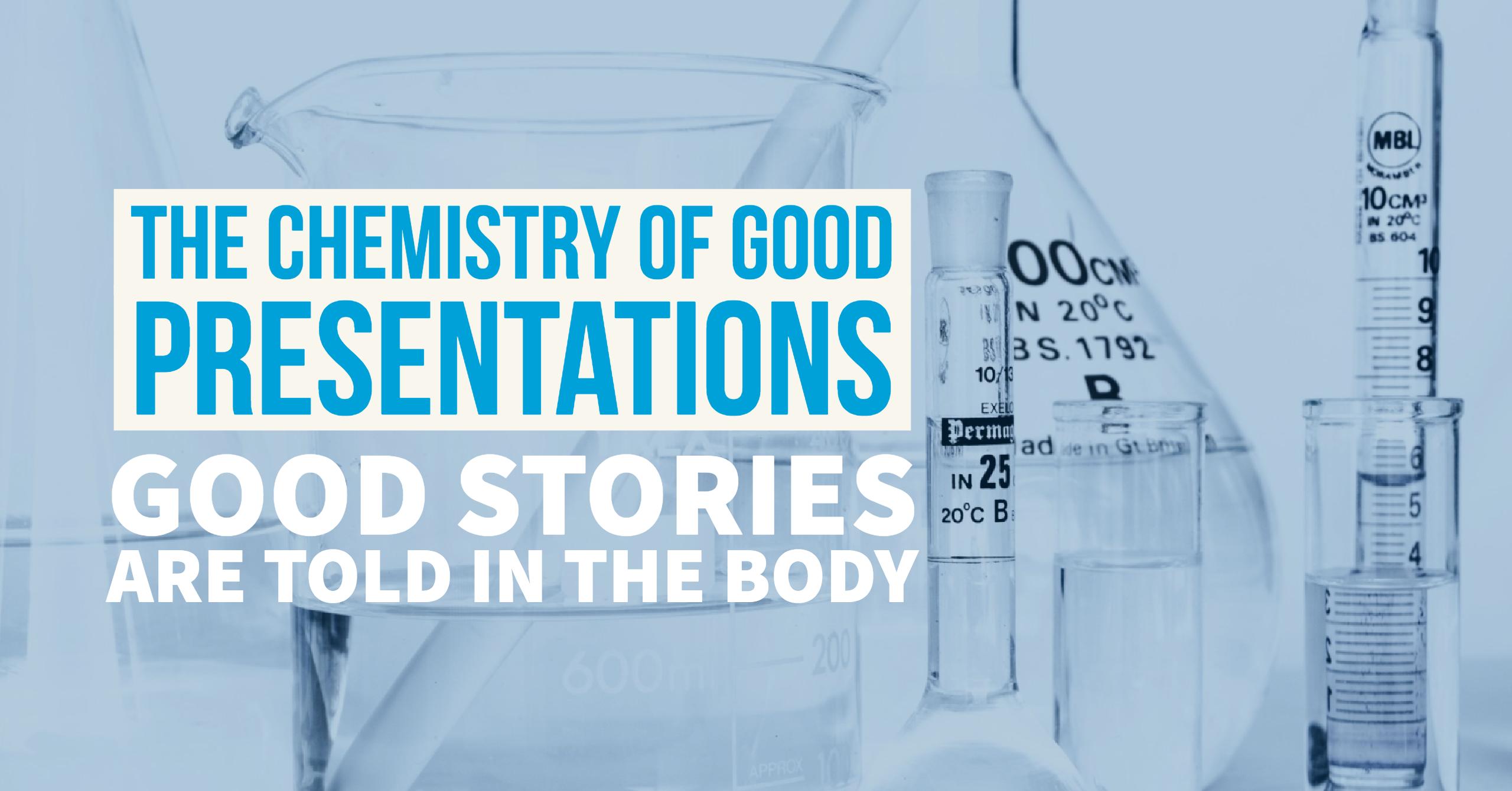
Any number of things contribute to good presentations, not the least of which is their content, but there are other things at play that influence and persuade your audience to either buy in and believe or back away and withdraw their attention.
Context matters. Where are you when you begin your story? Where is your audience? Are you on a teleconference call unable to read visual cues? Are they mentally distracted? Perhaps sitting next to an annoying co-worker? These things matter to their ability to receive your message.
How you frame your message matters too. People will react to the identical information in different ways depending on how it is framed. Are you talking to them in a way that is persuasive to you or in a way that works for them? This is why knowing your target audience is such an important part of delivering effective presentations. Ask questions, find out what’s going on in their heads and build your presentation to suit.
The other thing that’s happening during a presentation is that you are interacting with human chemistry. As you present you are trying to release certain chemicals, chemicals that increase their attention, chemicals that increase their trust, and chemicals that make them bond with you or give you money. Yes, there is a chemical that does that. The job you have when delivering your pitch is to get this cocktail of chemicals going because good stories are told in the body.
The first chemical we encounter on our way to a good presentation is cortisol. It’s released in you as a nervous presenter.
Cortisol – Focus
Cortisol is made by the adrenal glands and it helps the body to manage stress. As a presenter, the stress you feel before you speak is actually going to help you to deliver a better presentation. As you begin to feel that early freak out in anticipation of your presentation, your glands will release cortisol. This sharpens your attention, increases strength and helps you to produce more speed. Fight or flight.
That attention and that strength are your allies, use them… watch the speed, you don’t want to talk so fast that you can’t be understood… don’t forget to breathe.
Dopamine – Reward
Dopamine is a neurotransmitter that is part of the brain’s reward system. When dopamine levels are higher it produces more focus, more motivation and better recall, not a bad combination for receiving new messages.
Dopamine is released when we win a game, answer a quiz correctly or get some new likes on Facebook. This is part of what makes social media so addicting and it’s also why gamification has been such a successful marketing approach. If you can make dopamine levels rise in association with your brand, you create a positive experience that will serve your brand well. So how can you do that without spiking the air vents?
- Thank your audience for giving you the opportunity to speak.
- Play games with your audience; begin your presentation with simple skills testing questions.
- Share insights or ideas they might not have come across and reward listeners if they can discover information.
- Anticipation can release dopamine, so building suspense in a story can work to trigger the release of dopamine.
So now you’ve got cortisol making you more attentive and dopamine is making your audience feel good. The next step is to get your audience to release oxytocin, the cuddle chemical.
Oxytocin – Empathy
Oxytocin is a powerful neurotransmitter that generates trust and creates bonds. It’s the love hormone. When oxytocin is released your audience bonds with you, they feel empathy. If you’re looking for investment or donations, this is your chemical of choice.
So how do get it? Oxytocin is released when you have sex, give birth or breastfeed. Now depending on the business, you are in, these may seem like extreme lengths to go to get buy-in, so how else can you achieve this?
- Tell a character-driven story that draws your audience in and creates empathy. Think about the first time you meet Harry Potter. The boy who lived, that poor baby. That poor baby that became a lonely boy living below the stairs. His awful life with his obnoxious aunt and uncle and horrible cousin.
- Your story has to operate at the human level.
- It has to include a struggle with building tension.
- A story that leads to a climactic moment or resolution.
This story should take place after you’ve said your hellos and played with the audience a little. This story should reflect the current challenge your audience is facing. This story sets the scene for how your idea, product or activity will save the day.
I should add a word of warning about oxytocin. While oxytocin is the love hormone, it can also be the hate hormone. It is known to increase levels of envy and gloating. It’s also associated with increasing levels of distrust towards those who are the outside of the group.
Endorphins – Pleasure
No discussion on the chemistry of a great presentation would be complete with some discussion of endorphins. Endorphins are released for a number of reasons but the primary triggers are stress, fear and pain. Endorphins kick in to provide pleasure and a sense of well-being. Endorphins also make you more creative, more relaxed and more focused
In the context a presentation you want to look at endorphins in two ways, the release that makes you feel good about what you are doing and how to release that feeling in your audience.
For you this means using the natural high that comes from your bout of nerves to give your presentation more life, more passion, this is then conveyed as authenticity to your audience. So how do you do this for your audience?
- Make them laugh, tell a funny story.
- Alcohol is also a release, its why so many business deals happen over dinner.
- Spicy foods have the same effect.
So there you have the cocktail of chemicals that represent a great presentation. Cheers!
Related Articles:

I love this post, Debra. Very interesting how different chemicals in the body come into play at different stages of the presentation. I think I hear a Toastmasters speech coming on!
Hahhahahhaha… now there’s a speech I’d love to hear. Given your experience as a speaker, I bet you get all the right chemicals going.
What an interesting post – I have never thought about presenting material in a way that gets (or uses) a chemical response. I think these are great, actionable tips!
~Jess
Thanks Jessica, I thought it was a fun way to look at presentations.
Thank you Debra:
As a frequent presenter it was good to read what chemically happens in good presentations; one can feel it and see it in the faces of the participants or audience. After reading your article I will plan for the release of these magic little hormones! I will use what I intuitively knew in a more conscious manner. Carole
Thanks,
Carole, I thought the information was helpful in understanding what’s happening with your audience and gives you the ability to tweak your intuitive knowledge with a little chemistry. 🙂
Hope all is well with you!
Great post Debra!
I like the fact that you have broken down the various chemicals and described the effects they have on the body.
As part of my leadership role, I am required to speak publicly. The nerves though nowhere as bad as when I first started, keep me on my toes.
Thanks, Phoenicia it’s a fun exercise to understand what’s happening and why when we present.
How to engage your audience is crucial. Agree with you about the importance of telling a story and making them laugh as well as asking questions. That works. It seem, however, that chemistry isn’t always enough. At university we had to make presentations about problems in Swedish grammar last spring. One student who is not very bright was so nervous she was shaking, read the whole presentation and was even constantly biting her nails. Presumably chemistly can work against people with low self confidence. But they would do better if they asked questions and so forth to engage their audience. Maybe simply make them laugh at her nervousness would have done the trick. Normally that’s a no-no but in extreme cases like the one I mention it would probably be a good idea.
Poor thing sounds like she had a horrible time with her presentation. Our chemistry can definitely work against us. I used to get so nervous before presenting that I’d shake. Now I use that energy to make the presentation more dynamic.
Debra — I’ve done presentation training and done many presentations, but this is the first I’ve read about the chemistry involved. I do believe that the nervousness you feel before a presentation is good. It sharpens your senses. Telling stories will engage your audience. Also, when explaining something, the magic words are, “For example…” You will actually see members of the audience lean in to hear what you have to say. Stories, examples, humor. These are all essential to a compelling presentation.
Jeannette, I love the “for example” tip. It works every time. I don’t think the chemistry is the first thing I’d focus on when preparing a presentation. However, understanding the chemistry is a good way to understand why things work.